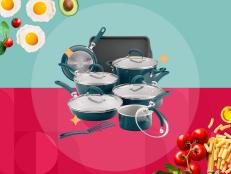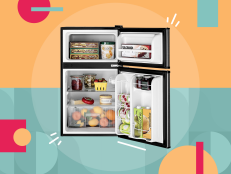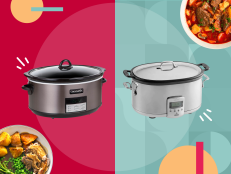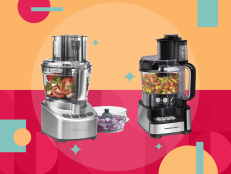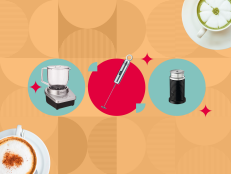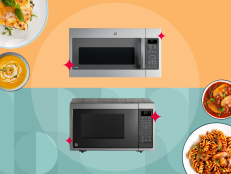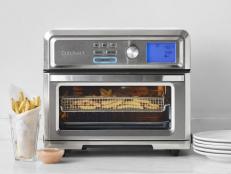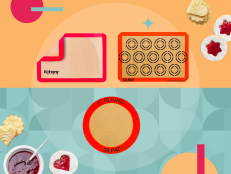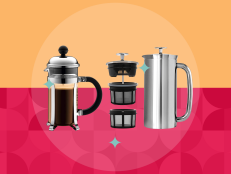5 Best Pasta Makers of 2024, Tested and Reviewed
We mixed, rolled and extruded to find the best maker for noodles, ravioli and more.

Our Top Pasta Maker Picks
- Best Overall: Marcato Atlas 150 Pasta Machine
- Best Electric: Philips Artisan Smart Pasta & Noodle Maker
- Best Mixer Attachment: KitchenAid Pasta Roller Attachment
- Best Variety: KitchenAid Gourmet Pasta Press Attachment
- Best Value: Imperia Pasta Maker Machine
Tested by Layla Khoury-Hanold for Food Network Kitchen
Making homemade pasta can seem daunting at first, but having the right tools can make the process a fun, seamless experience. Pasta makers come in manual and electric models and some can make a variety of shapes like penne and fettucine. In testing, we found manual pasta machines work well with just about any dough recipe, while electric pasta machines perform best when using the dough recipes provided by the manufacturer. We tested the pasta makers with eggless and egg-enriched doughs, plus we ran a cracker dough through the machines to test for durability. Ultimately, we found five pasta machines in a range of styles and price points that will work for whatever kind of homemade pasta is your favorite.

Layla Khoury-Hanold
What to Consider Before Buying a Pasta Maker
Manual vs Electric: First, you’ll need to decide if you want to purchase a manual or an electric pasta maker. Manual machines are secured to a table or countertop and make pasta by feeding the pasta through rollers that are operated with a hand crank. Manual pasta makers are best for making thin sheets of dough, say for lasagna or filled pasta like ravioli. Electric pasta machines tend to be easier to use than manual ones, particularly for beginners, since many electric machines also mix and knead the dough for you. The cutting of the pasta is more hands-on as you have to cut the pasta to the desired length as it’s extruded.
Price: Manual machines are less expensive than electric machines, but as the name implies, you do more of the work. Electric machines range in price depending on design features. For example, a smart machine with pre-programmed settings and a built-in scale for measuring flour and calculating ideal liquid ratios will cost more than one that just extrudes the pasta.
Size: Manual machines take up less space than electric machines. If kitchen space is at a premium, but you still want an electric machine, look for compact designs and those that include built-in storage for things like shaping discs and cleaning tools.
Material: Look for machines that are made of stainless-steel rather than plastic or aluminum. Heavier stainless-steel machines tend to have greater stability and offer more durability in the long run. Electric machines vary in materials and we found that the machines that were more well-made tended to cost more, but that’s not always an indication of value.
Dies and Cutters: When selecting a pasta maker, you’ll want to consider what type of pasta you most frequently make or would like to have the ability to make. Manual machines (as well as some mixer add-ons) come with cutter attachments that allow you to make lasagna sheets or long, flat noodles such as fettucine. Electric machines (as well as mixer attachments) come with dies (shaping discs) to attach to the extruder, so you can make long noodles like spaghetti, fettucine or bucatini, tubular pasta such as rigatoni or penne, and short pasta like elbow or fusilli.
Accessories: Most electric pasta makers come with additional accessories, such as a pasta cutter, cleaning tool, and measuring cups for flour and liquid. One machine came without a cutting tool and while we could snip spaghetti with scissors, cutting tubular shapes without a cutting tool proved challenging. You'll want a cleaning tool — it can be tricky to remove pasta dough from dies without a sharp pick or to remove dried-on dough without a brush.

Layla Khoury-Hanold
How We Tested
We purchased nine top-rated pasta makers according to various online sites, reviews and bestseller rankings. We tested both electric and manual machines across a range of price points.
First, we noted the basics including product name, price, type of machine, material and size. Next we recorded whether the pasta maker came with a manual or label that included instructions for assembly, use, and disassembly, as well as suggested care instructions, including if any of the pieces were dishwasher safe. We recorded how many dies and accessories were included, as well as any notable design features and special claims.

Layla Khoury-Hanold
For each pasta maker, both manual and electric, we tested egg-enriched fresh pasta dough as well as an eggless dough. For the manual pasta makers, we also tested a cracker dough recipe to assess durability. For the manual pasta makers, we flattened the dough then rolled it through the machine on all thickness settings, noting how easily the dough ran through the machine and how it handled any stickiness. We also tested both the egg-enriched and eggless doughs un-flattened on a thin setting (level three) to see how the machine handled any clogs.
For the electric pasta makers, we tested both egg-enriched and eggless pasta doughs and noted how easily the machine handled the dough. We also tested the recipes included in each machine’s manual, and found that across the board, for electric pasta makers, the manufacturer’s recipes work best. So, we advise utilizing whatever recipe comes with your pasta maker; if you do try a cookbook recipe, don’t be surprised if it doesn’t work. With each type of dough, we also tested most of the included extruder disc attachments, including at least one tubular shape, to determine how evenly and consistently the machines produced various pasta shapes. We also took note of how easy it was to cut the pasta using the included tool and if there was any clumping.
For the final part of testing, we noted whether any of the pieces were dishwasher safe and handwashed the machine and parts, noting how easy or difficult it was to clean the parts and discs by hand.
This stainless steel, Italian-made manual pasta maker edged out the competition with its ergonomic clamp and crank, seamless performance and durability. It has nine thickness settings for rolling dough and comes with a changeable cutter as well. We found that the machine performed best on settings one through six. In testing, the thinner settings didn’t perform as well as evidenced by slight tearing and a little sticking. If the dough starts sticking, you may find that you need to dust the dough with flour (we didn’t, in order to keep testing variables to a minimum). It also handled un-flattened dough well without any clogging and only a little bit of tearing and slightly uneven thickness. We appreciated that it came with a clear, easy-to-read manual and a handy chart indicating the ideal thickness setting for various types of noodles. This machine also offers great value, and its performance is backed by a 10-year warranty.
This is the best electric pasta maker because it was so easy to use, delivered a flawless performance and came with a detailed manual and top-notch accessories, including 10 discs for different pasta shapes (plus in-unit storage), a cleaning tool, pasta cutter and liquid measuring cup. The machine also comes with a built-in scale for measuring flour and a smart screen that advises the exact amount of liquid to add. We tested its claim of making four portions of pasta in 10 minutes (and up to eight in 15 minutes), and we found that the machine delivered. The manufacturer touted its “Pro Extrude” technology, which promised a powerful motor and robust metal mixing paddle to create a smooth finish, which we found to be evident in the results. The penne disc yielded defined ridges and consistent shapes, the spaghetti strands were consistent without any clumping, and the lasagna sheets were smooth and uniform. The manual also states that this machine can be used to mix cookie dough. We appreciated that the machine was quiet and efficient while mixing and extruding, as well as a gentle sound alerting when the machine was finished. If you want pasta dough making to be a hands-off experience and want homemade pasta in 10 minutes, this is the machine for you. The intuitive design, clear manual instructions and smart screen and companion app also make this a great pasta maker for beginners.
We tested both the Philips Pasta and Noodle Maker Plus and the Philips Artisan Smart Pasta & Noodle Maker and found that the performance coupled with the variety of additional discs —including shapes like shells, tubular paccheri, lasagna and tagliatelle — to be that much better than th e regular machine, making the value worth the extra $50. The Philips pasta maker without smart capabilities is still a well-made machine and performs well, but it doesn’t have the bells and whistles and variety as the Philips smart pasta maker.
An important note: With all electric machines, we tested the recipes included in the manual and found that the manufacturer’s recipes work best for each respective machine. We’d advise against using cookbook recipes in electric pasta makers as the dough is often too dense to properly spin in the machine and reach the extruder.
We found this product to be durable, well-made and easy to use. It also performed well when we tested running flattened dough through the various thickness settings, and would be good for making pasta sheets for filled pasta or hand-cut noodles. It didn’t handle un-flattened dough as well and resulted in dough with a few tears, so it’s best to pre-roll or flatten this dough beforehand. When we tested the cracker dough, it fed through the roller easily but found that it didn’t produce as even results as the manual pasta makers. The roller attachment is easy to wash and dry by hand. We also tested the KitchenAid 5-Piece Pasta Deluxe Set Stand Mixer Attachment, which includes cutting attachments for making pasta sheets, spaghetti, fettucine, capellini and lasagnette noodles. So, if you’re looking for your KitchenAid to do more with pasta making, you might want to upgrade to the deluxe set.
If you want to be able to make several different pastas with your mixer, this pasta press attachment is tops. It’s a very well-designed unit that easily attaches to your KitchenAid and comes with six shaping discs, including spaghetti, bucatini, rigatoni, fusilli, and large or small macaroni. We appreciated that the discs themselves were also labelled to eliminate any confusion over the noodle shape. The easy-to-read manual also included a handy chart with the recommended mixer speed and extrusion length for each. The top-down feeding tube allows the user to seamlessly feed in small dough balls without any clogging and the built in wire-cutter yields easy and clean cuts every time. The spaghetti yielded defined strands with minimal clumping, the bucatini were uniform with only a little bit of sticking (and we could still easily separate the strands), and the fusilli and small macaroni discs consistently yielded a uniform shape. We also appreciated the tools that were included, including an effective cleaning tool and a combo-tool that serves as a wrench for changing out attachments and as a pusher to help feed dough through the extruder. The manual also comes with a basic egg noodle pasta recipe and cooking instructions for both fresh and dry pasta. This mixer attachment comes with a 1-year full warranty.
This manual machine easily rolled both the egg-enriched and eggless doughs, but it wasn’t as smooth as the Marcato Atlas 150. As with the Marcato Atlas 150, the Imperia performed best on the thicker settings and the dough started tearing and sticking on the thinner settings. Again, you may want to experiment with dusting the dough with a little flour to help aid the process. In the un-flattened dough portion of testing, the dough clogged and tore so we found that it wasn’t as durable. When cleaning the machine, we found that we could easily wipe the exterior of the machine clean, but you might need to use a toothpick to remove any stuck-on dough or crumbs. Additionally, the construction didn’t feel as sturdy, the clamp was harder to secure and the manual wasn’t as easy to read. If you’re planning to just make pasta once in a while, or are on a budget, this is the machine for you.
Tips for Using a Pasta Maker
Pre-use: Consult your user manual to determine if you need to wipe any of the parts off before using; even if it’s not explicitly stated, it’s a good idea to wipe down the exterior and the parts as dust particles can settle during warehouse storage and shipment.
Assembly: Some machines come pre-assembled, but many are shipped with components packed separately to ensure smooth transit. Be sure to follow the step-by-step assembly instructions in your user manual to avoid any malfunctioning.
Dough: We found that the electric pasta makers performed best when we tested them with the recipes included in the instruction manual. We’d advise using the manufacturer provided recipes rather than using fresh pasta dough recipes from cookbooks as the dough is often too dense to properly spin in the machine and reach the extruder.
Measuring cups: Many of the electric pasta makers come with measuring cups; it’s important to note that there is considerable variation in weight per cup of flour between different brands. It’s ideal to weigh your flour using a digital food scale; if you don’t have one, fill your measuring cup by scooping spoonfuls of flour into the provided cup and leveling off the top. It’s also important to use a liquid measuring cup for the liquid component of the recipe, as the volume is much different than measuring cups designed for dry ingredients.
Flour-to-liquid ratio: Each electric pasta maker’s capacity varies, so be sure to read the user manual to ensure that you are adding at least the minimum amount of dough required without exceeding the maximum. Be sure to also heed the suggested ratio of flour and liquid. If the ratio is off, the machine may not work at all, and the resulting pasta may be sticky or break easily. Note that when you make an egg-enriched dough, the whisked eggs are part of the liquid measurement. Additionally, it’s important to note that seasonal changes (like humidity) and ingredients from different regions might affect the flour/liquid ratio. It’s helpful when a manual includes images of what a just-right dough looks like in the mixing/kneading chamber (crumbly, like a coarse meal) versus too dry (too crumbly, resembling flour) or too wet (like a typical, non-pasta dough that’s more uniform in its consistency). If the pasta dough is too wet, it won’t extrude; it can be helpful to hold back 1 to 2 tablespoons of water (or liquid) as the dough might not require the full measurement.
Feeding the dough: When you’re first working with your manual pasta maker, you might find yourself wondering Why is my pasta dough holey or Why is my pasta dough tearing. When you feed the dough into the rollers, you want to ensure that the dough is flattened, and that you’re feeding it straight in, not at an angle, and at an even speed; otherwise, you may cause the dough to bunch and rip.
Thickness: As you roll dough through a manual machine on thinner settings, it can start to tear or get holey. Part of mastering a manual pasta maker is experimenting with adjusting to the nuances of the pasta dough and the machine. Don’t be afraid to dust the dough with a little extra flour to help prevent sticking. If the dough has gotten too warm, chill and bring the dough back to room temperature before re-working it.
Storing noodles: After you cut noodles to the desired length, place them on a parchment-lined sheet pan. You can loosely fold long pasta noodles into nests and dust them lightly with flour to prevent strands from sticking together. Cover with a clean kitchen towel in between extrusions. After you’re done extruding, you can cook the pasta immediately or store it in the refrigerator for up to 2 days. Uncooked pasta can be frozen for up to 3 weeks—place the sheet pan of cut pasta noodles in the freezer until semi-frozen, then transfer to freezer-safe bags or containers.
Cleaning: For electric pasta makers, be sure to let the shaping discs air-dry with dough on them for 2 to 4 hours, then use the accompanying cleaning tool to poke the dough out through the holes. It’s more challenging to clean the discs when the dough is fresh. Wash the lid, bowl, auger and other removable parts in warm, soapy water, rinse and wipe clean. Use a dry cloth (or a slightly damp cloth, as necessary) to clean any dough or flour residue on the exterior of the main unit and control panel. Avoid using scrubbing dish brushes or chemical cleaners on any part of the machine as it may damage it.
Most manual pasta makers suggest cleaning the machine using a cloth and a soft brush and advise against washing the machine or accessories in water (or in the dishwasher). Turn the thickness regulator/dial to the widest thickness setting to more easily access any dough stuck on the rollers. To clean the cutting rollers, remove the combs underneath, if possible, to ensure a more thorough cleaning.
Machine storage: Ensure that your pasta maker has cooled down and that all parts are clean and dry before storing.





























